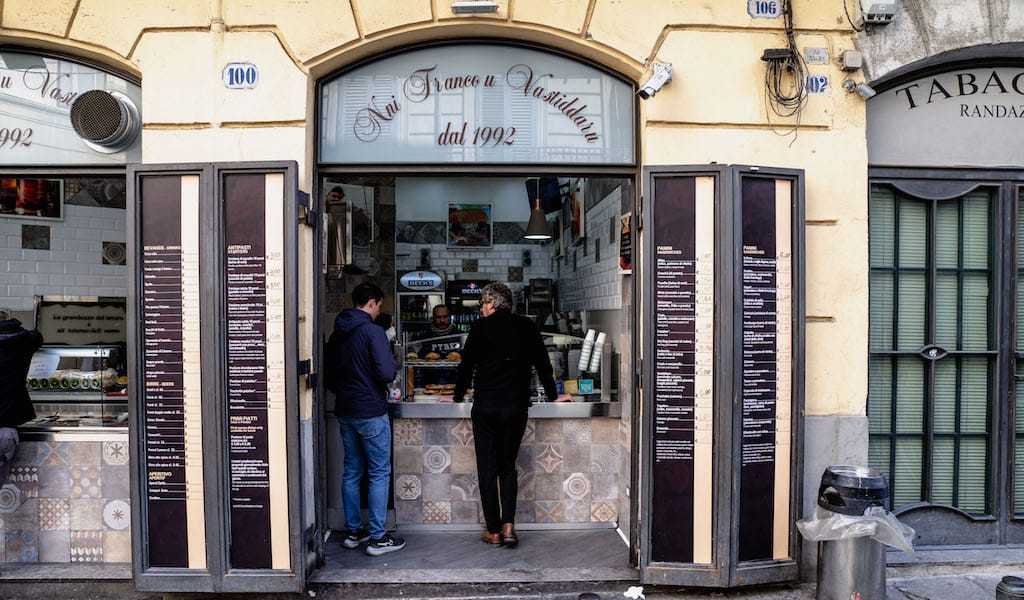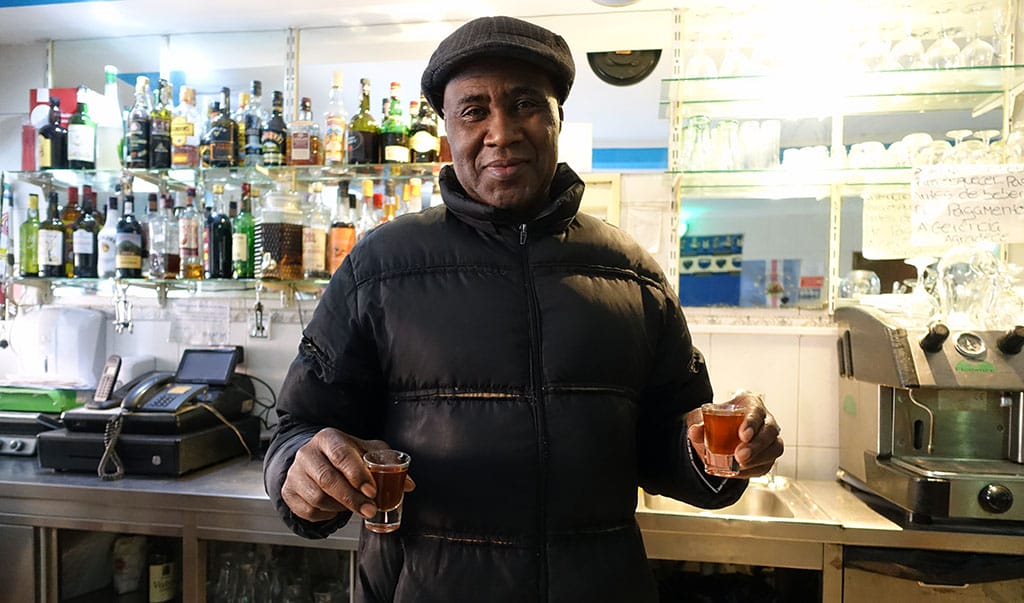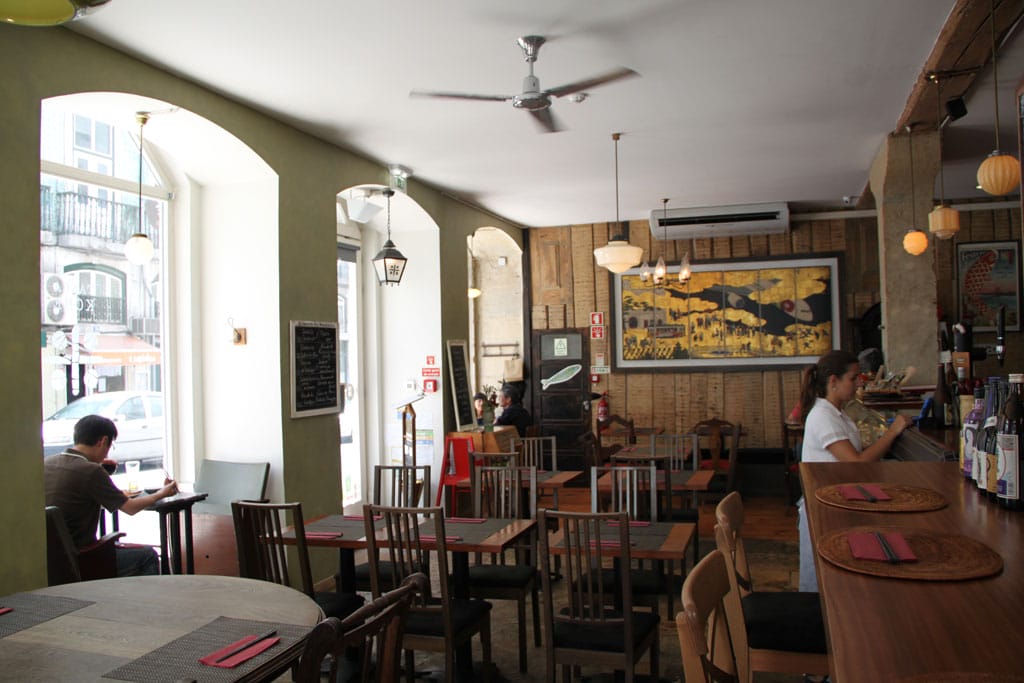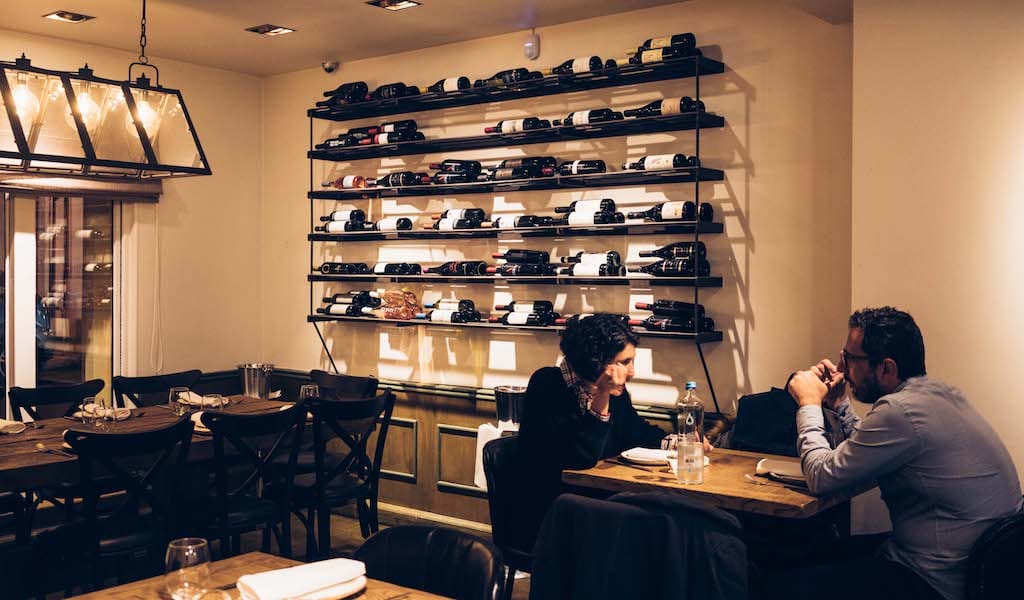Walk around Piazza Marina and you will come across several city monuments and historical sites. You’ll be enchanted by Palazzo Steri, which today houses the university rectory but until a few centuries ago was home to the infamous Inquisition Tribunal. You will also find the place where the famous New York policeman of Italian origin, Joe Petrosino, who came to Palermo to investigate the Sicilian mafia, was murdered in the early 20th century.
At the center of the square, in Villa Garibaldi, designed by the famous architect Basile and dedicated to the leader of the Unification of Italy, stands the largest Ficus tree in Europe: a true natural monument that unloads the weight of its prominence on branches that end up expanding its roots by breaking their way through centuries-old sidewalks.
And then, at the corner of Piazza Marina and Via Vittorio Emanuele, there is the fried food shop Nni Franco U Vastiddaru: this, too, is a city monument.

The first time we stop by to speak to the owner, Fabrizio, we find him sitting behind the cash register wearing an apron. Placing his hand on his heart, demonstrating his sincerity, he asks us if we can return the next day, “The truth? I just put the spaghetti in the pot for the squid ink sauce…in five minutes I have to take it out. This pasta has to be eaten hot, you know?”
We understand, but most of all we appreciate Fabrizio’s sincerity and order of priorities. Therefore, we leave him to his well-deserved dinner with plans to return.
The next day, when we arrive, Fabrizio looks at us, surprised: “You could have warned me; I would have put gel in my hair for the photo,” he says, leaving us confused for a moment before we realize he is joking. We sit with him as he orders on our behalf an atturrunata, (iced) beer, as Palermo tradition dictates.

Fabrizio is the son of Franco Basile, who died a few years ago after a life working as a Vastiddaru. The Vastiddaru is a sandwich-maker who stuffs the vastedde, the typical round loaf of bread used for the two symbolic sandwiches of Palermo street food: the spleen sandwich and the panelle and potato croquette sandwich. Before setting up his own business with his two sons, Mr. Franco Basile worked for 28 years at the Antica Focacceria San Francesco, another city institution.
Fabrizio points us to two phone booths a few meters away, among the few left in town after the advent of mobile phones. “We started there with a Sicilian cart that only made spleen sandwiches. My father Franco, my brother Tony and me, when I was 14 years old. It was Dec. 8, 1992,” he says. “Then, slowly, we expanded.”

After starting with a street cart on the edge between Via Vittorio Emanuele and Piazza Marina, Mr. Basile opened his own place, first selling takeout sandwiches and then, over time, expanding with indoor and outdoor tables.
Today, Nni Franco U Vastiddaru offers its customers a wide choice of dishes, from the 30 or so sandwiches on the menu to caponata, parmigiana and an assortment of must-try fried foods. Fabrizio advises his customers to start with a fritto misto, which includes the classic panelle made of chickpea flour; potato croquettes; arancine rice balls with ragù; arancine with ham and mozzarella; and finally the crostini, one of their specialties: double white bread stuffed with prosciutto, mozzarella and béchamel, then breaded and fried.

Next, try one of Palermo’s classic sandwiches: the spleen sandwich or the panelle e crocchè sandwich. Of the latter you will also find the variant with an addition of some slices of eggplant, obviously fried: it is called Triplo and is a real treat. We are left wondering whether the Triplo is a Palermo specialty or an invention of theirs later copied by other fried food shops, but not even Fabrizio knows.
“I can’t tell if it was my father who invented the Triple, but for sure he was the God of Spleen, I can guarantee. Nobody beats him: this I say with certainty.”
The spleen sandwich is not just a sandwich; it is a symbol of Palermo’s culinary tradition. To annoint his father as the “God of Spleen” is a responsibility by no means taken for granted. With the veneration of a son who remembers his father and the passion of the man who inherited the vasteddaro trade from him, Fabrizio explains the long preparation of the spleen and why, in his opinion, his father was the best in town.

“My father, as soon as the spleen arrived, was able to tell you what type of a spleen it was just by looking at it. I had this gift too, to recognize whether it’s cow spleen, male spleen, female spleen, whether it’s a young lung or an old lung. The difference is minimal; it’s not easy. Normally, calf spleen is used. Cow is big and tough, the flavor changes very little, but the connoisseur, someone who knows, can tell. You can tell it’s a female calf because it is pink and has to cook less; it is more tender and sweet. It is more difficult to know if it is an old calf – even with 30 years of experience, it is difficult to tell the difference. You have to be a ‘tradesman’ and love this job.”
It is called a spleen sandwich, but, as Fabrizio explains, it is actually prepared with different cuts:
“Spleen sandwich is composed of three elements, maybe four: lung, spleen, carninicchi, which would be the thickest part around the heart: it’s the best part of the sandwich, because it’s sweet. It’s like if you take a slice of meat without fat in it: it comes out tough. And then there’s the scannaruzzatu, in Sicilian, which would be the esophagus, the trachea, with pieces of cartilage. It’s all washed thoroughly, then it’s boiled to a standard 140 degrees and dried, then it has to be put in the blast chiller. After that, we cut it with a knife: the thickness is important. It is not easy to make a spleen sandwich. I sell hotdogs as well – I sell them for 3 euros, while a spleen sandwich sells for 2.50, but there is no comparison. You have to know how to prepare it; as the Sicilians say, it’s camurriusu, meaning it’s a long, tough job.

At this point in the conversation, we ask Fabrizio to help settle a Hamletic doubt: is the spleen sandwich better “schietto” or “maritato”? There are in fact two versions: schietto means single, maritato means married.
“Do you want to know the difference?” he asks us.
“We know the difference,” we reply, slightly offended.
“No, I bet you don’t know the difference,” Fabrizio insists.
And here we fear we are about to embarrass ourselves, but venture anyway:
“Schietta is with lemon, maritata is with cheese.”
“No, wrong, you are lightyears away. Do you see that you don’t know?”
Speechless, we let Fabrizio enlighten us:
“Maritata is the sandwich with spleen, ricotta and cheese. Schietta, on the other hand, is just ricotta and cheese without the spleen. The ricotta and cheese are heated in a pot with lard and then served in the sandwich. Schietta is just white: ricotta cheese and cheese. Pure. All white. And then it gets married with the spleen.”

Faced with our embarrassed silence, Fabrizio exclaims with satisfaction: “I told you you didn’t know!” and then consoles us by confessing that many people fall for the trick: “Many people ask me, ‘Will you give it to me schietto?’” he says. “But I can eyeball a customer who isn’t aware and I explain the difference. Many are surprised to be served a cheese sandwich instead of a spleen sandwich.”
Fabrizio’s mobile phone rings, the ringtone is the theme song of the anime Lupin III, which was in vogue when he was a kid. While he answers the call, we walk around the shop. Outside are school kids on a field trip eating panelle sandwiches, an elderly couple sitting in the shade, a family of tourists, and a long line waiting their turn for takeout. Inside, Fabrizio’s employees are stuffing sandwiches, making up to 100 kilos of potato crochettes, frying all the time. But what strikes us most is a portrait of Franco, who is now deceased, displayed on a sign that reads “The greatness of work lies within the man.”

To understand who the man was, other than being the God of Spleen, we return to Fabrizio to ask him about his father, Franco. He gets emotional remembering him and smiles, hinting at a giggle that does not contain a shred of melancholy:
“My father was an institution; he was the father of the poor. He did a lot of charity, he understood if you were in need, he knew how to behave. If you had 10,000 lire, he would give you 50,000 to go grocery shopping. The only flaw he had was loving work too much: he was capable of getting here at 6 a.m. and leaving at 1 a.m. the next day. Then he got sick and it ended, but until a few days before he died he was here working. He struggled but did not make it: it was the will of God. So many people came to his funeral; there was a never-ending procession,” Fabrizio says, using the length of the funeral procession as a measure of the love, appreciation and respect people had for Franco Basile.
Fabrizio grew up here and is destined to live here, and works with the same dedication as his father.
“As a kid I dreamed of being a soccer player, but other than that, I have no regrets. I grew up with the hardworking mentality that I inherited from my father. Although it is a very busy life, I have always enjoyed contact with people and talking to customers.”
Perhaps it is this love and dedication to one’s work that makes the difference between an ordinary vastiddaru and the God of Spleen. And in the titanic feat of matching his father, Fabrizio is well on his way.
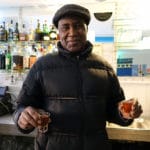 March 29, 2017 Post-Colonial Lisbon: Cape Verde Edition
March 29, 2017 Post-Colonial Lisbon: Cape Verde Edition
Once the hub of a trading empire that connected Macau in the east to Rio de Janeiro in […] Posted in Lisbon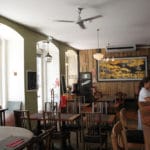 August 15, 2016 Tasca Kome
August 15, 2016 Tasca Kome
Editor's Note: This spot is sadly no longer open.
After almost a century of […] Posted in Lisbon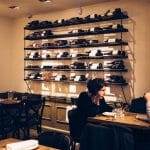 November 20, 2018 Farma Bralou
November 20, 2018 Farma Bralou
Damis Pithis has led a global life. He left his home on the island of Chios at the age […] Posted in Athens
Francesco CiprianoFrancesco Cipriano
Published on March 21, 2023
Related stories
March 29, 2017
LisbonOnce the hub of a trading empire that connected Macau in the east to Rio de Janeiro in the west, Lisbon today can at times feel like a sleepy town of nostalgic storefronts and scenic churches. But that’s only its façade. Take a closer look and you’ll discover a city that still maintains deep-rooted links…
August 15, 2016
LisbonEditor's Note: This spot is sadly no longer open. After almost a century of desertification, it’s sometimes hard to believe the state of downtown Lisbon – Baixa – today. Hotels, startups, boutiques and restaurants are exploding up and down these long, narrow avenues, which have a plan similar to that of 18th-century Parisian thoroughfares and were abandoned…
November 20, 2018
AthensDamis Pithis has led a global life. He left his home on the island of Chios at the age of 17 to move to London. There, over the years, he built a successful career in the shipping industry. But at the age of 48, he felt like it was time for a change. Leaving behind…







































